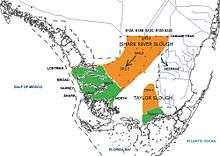Shark River Slough
Shark River Slough (SRS) is a low-lying area of land that channels water through the Florida Everglades, beginning in Water Conservation Area 3, flowing through Everglades National Park, and ultimately into Florida Bay.[1] Together with Taylor Slough to the east, Shark River Slough is an essential conduit of overland freshwater to Florida Bay. Shark River Slough is also known as the "River of Grass."[2]

Description
Shark River Slough is the dominant path for flow of water into Everglades National Park.[3] SRS is a mixture of sawgrass marshes, tree islands, sloughs, and wet prairies.[4] The SRS is bordered by marl prairies.
Everglades restoration
Historically, Shark River Slough was the primary path for water flow in the Everglades system.[5] Restoration of the historic function of the slough is essential to restoration of Everglades National Park.[6]
Tidal influence
Shark River Slough has tides from the Gulf of Mexico that reach 30 km inland.[7]
See also
- Taylor Slough
- Cape Sable Seaside Sparrow
- Everglades
- Everglades National Park
References
- "Ecosystems: Freshwater Slough". nps.gov. National Park Service.
- "Ecosystems: Freshwater Slough". nps.gov. National Park Service.
- Riscassi, Ami. "Flow Velocity, Water Temperature, and Conductivity in Shark River Slough, Everglades National Park, Florida: August 2001-June 2002". usgs.gov. U.S. Geological Survey.
- Riscassi, Ami. "Flow Velocity, Water Temperature, and Conductivity in Shark River Slough, Everglades National Park, Florida: August 2001-June 2002". usgs.gov. U.S. Geological Survey.
- "Ecosystem History of the Southwest Coast-Shark River Slough Outflow Area". sofia.usgs.gov. U.S. Geological Survey.
- "The Shark River Slough". nicholas.duke.edu. Duke University Wetland Center.
- "sofia.usgs.gov". A Hydrological Budget (2002-2008) for a Large Subtropical Wetland Ecosystem Indicates Marine Groundwater Discharge Accompanies Diminished Freshwater Flow. U.S. Geological Survey.